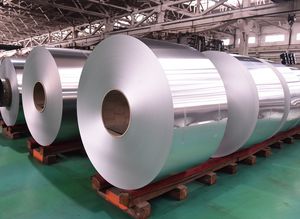
- Materials - Tools - Components
- Semi-finished products
- Aluminum coil
- Henan Chalco Aluminum Fabrication Co., Ltd.
- Products
- Catalogs
- News & Trends
- Exhibitions
Aluminum coil 8 series



Add to favorites
Compare this product
Characteristics
- Shape
- coil
- Width
Max.: 1,800 mm
(70.87 in)Min.: 900 mm
(35.43 in)
Description
Aluminum coil is the rolled product that has been calendered by a finishing mill but has not been processed by a leveling flying shear. It is the raw material of aluminum strip and aluminum sheet. The slitting equipment can cut aluminum coil into aluminum strip, and the flattening equipment can make aluminum coil into aluminum sheet.
Aluminum coils can be divided into different types according to different alloys, applications and surface treatments.
Features: this series of alloys has a wide range of applications, such as building exterior walls, beverage bottle caps, pharmaceutical packaging, food packaging, cable foil, milk cap materials, sealing foil, etc.
Features: 8079 aluminum coil has the characteristics of good elongation and spreading pressure, clean oil removal, less pinholes, good product shape, and no deformation during cutting. It is usually used as lunch box materials, medicine capsules, food packaging, battery soft bags, etc.
Aluminum coil classification according to the surface treatment process
Color coated aluminum coil
Color coated aluminum coil is to paint the surface of aluminum substrate. Common color coated aluminum coils include fluorocarbon (PVDF) color coated aluminum coils and polyester (PE) color coated aluminum coils. Chalco Aluminum can also product black color coated aluminum coils, white color coated aluminum coils, wood grain aluminum coils, stone grain color coated aluminum coils, etc.
The polyester (PE) coated aluminum coil is formed by baking and coating polyester (PE) materials on the surface of aluminum coil for many times.
Other Henan Chalco Aluminum Fabrication Co., Ltd. products
Aluminum Coil and Strip
*Prices are pre-tax. They exclude delivery charges and customs duties and do not include additional charges for installation or activation options. Prices are indicative only and may vary by country, with changes to the cost of raw materials and exchange rates.





